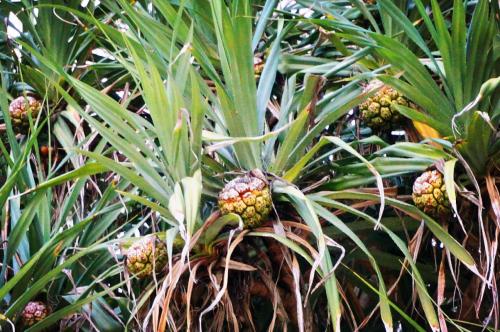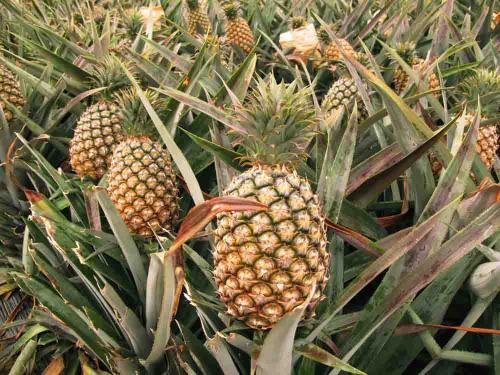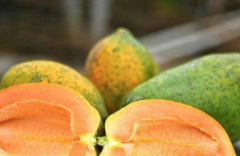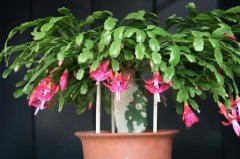Pineapple planting methods and techniques, pineapple need to be planted every year? what are the planting requirements?
Pineapple, a kind of fruit, is very popular in spring and summer. Do you know how it is grown? Do you want to know about it? Let's have a look!
(1) Land preparation
When cultivating pineapple, the reclamation and arrangement of garden land is very important, and the extensive and fine land preparation will affect the yield and quality of pineapple in the future. Therefore, in flat land cultivation, large tractor should be used to plough and rake the soil flat, and excavator can be used instead of slope cultivation, which can not only save time and effort, but also make the degree of deep ploughing more than 30 cm. It is beneficial to bury stubborn weeds and residual topsoil pests and pathogens into the deep soil. The flat land with poor drainage should be cultivated in high border, and make a good drainage system around the garden, so as not to affect the growth and quality of the plant by soaking in water. In order to open up pineapple orchards on the slopes, attention should be paid to contour planning and detailed arrangement of orchard roads, so as to facilitate the entry and exit of vehicles and cultivators and the convenience of operation, and planting pineapples along the contours can prevent soil erosion. After the completion of soil preparation, organic fertilizer 10000 ∼ 15000 kg, ammonium sulfate 915kg, calcium superphosphate 880kg and potassium chloride 530kg per hectare should be applied as base fertilizer, and the soil pH value should be adjusted to between 4.5kg and 6.0kg.
(2) coverage
The border covering operation of pineapple cultivation is also very important, as shown in figure 11, which is covered with black PE plastic cloth, which has the characteristics of economy, labor saving, cleaning and convenient operation. Covering with plastic cloth can not only prevent weeds and soil erosion, but also increase soil temperature, which is beneficial to the growth and yield of pineapple.

(3) planting period
The planting period should be calculated according to the target production month. For example, if you want to harvest in April of the following year, you should choose Tainong 17, plant it in October last year, and promote flowering in October this year. If it is scheduled to be planted at the end of the year, there will be crown buds, descendant buds, sucking buds, etc. if they are planted in early spring, they can only be propagated by crown buds and sucking buds. Soon after planting, the rainy season will enter, and the temperature will gradually rise, which is beneficial to the growth of plants. Pineapple is a perennial crop with a long cultivation period. At present, the commonly adopted cultivation system is to harvest two fruits in one crop, that is, to harvest fruit twice in three years as a renewal period, and the planting density and arrangement have changed from scattered or multi-row planting (about 50 ∼ seedlings per hectare) to two-row triangular dense planting (35,000 to 40,000 seedlings per hectare). The appropriate border distance is about 100cm and the row spacing is about 50cm. The distance between plants is 36 ∼ 30 cm.
(4) Weed control
Among the common weeds in Taiwan pineapple orchards, weeds of Compositae, Gramineae and Cyperaceae are the most common. If the weeds in the cultivation garden are too luxuriant, they will directly affect the transmission and ventilation of sunlight, encroach on the space of pineapple plant development, and compete for the necessary nutrition and water, which hinders plant growth and reduces pineapple heading rate and yield, so it is necessary to control weeds.
(5) covered with black PE plastic cloth
Usually pineapple orchard from planting to the first harvest, if weeds are manually controlled, they must be carried out at least 10 times, especially in the rainy season, the weeds grow rapidly and cannot be eliminated, and the production cost is increased. in addition, it is not easy to hire workers and delay the weeding period, which will affect the growth and fruit yield of pineapple plants. therefore, covering with black PE plastic cloth before planting can prevent the growth of weeds and achieve the effect of timely weeding.
(6) Irrigation and fertilization
1. Irrigation: although pineapple is a crop with strong drought tolerance, it can grow and harvest even without irrigation, but when water supply is insufficient, it will still affect growth and fruit, especially in the dry climate from October to March of the following year. Rain Water is often short of water, so that if an appropriate amount of water can be supplied during this period, it can promote plant growth and development, improve yield and quality.
2. Reasonable fertilizer management and appropriate fertilization can make pineapple plant growth exuberant, high yield, early bud absorption, and increase the yield of the next year. The current fertilizer management method can cooperate with the operation before plastic sheet mulching, and the partial differentiation fertilizer (30% nitrogen fertilizer, 100% phosphate fertilizer, 50% potassium fertilizer) can be applied to the soil together with organic matter fertilizer, so as to reduce the number of times of topdressing. The remaining fertilizer was applied 3 or 2 times after 6 months, 9 months and after flowering, or 6 months after planting and after flowering. When topdressing was applied for the first time, it was suitable to be applied to the soil because the plant was still small, and the second ∼ and the third topdressing could be applied to the basal leaf axils of the plant.
3. Fertilizer application amount
During the period from planting to the first harvest of pineapple, each plant needs about 16 grams of nitrogen, 4 grams of phosphorus and 16 grams of potassium. If 40, 000 plants are planted per hectare, 3050 kg of ammonium sulfate (or 1390 kg of urea), 880 kg of superphosphate and 1280 kg of potassium sulfate (or 1060 kg of potassium chloride) are required. The amount of nitrogen and potassium can be halved.

(7) Regulation of the period of delivery
In order to avoid short-term or seasonal unsalability and affect farmers' income, it is often necessary to adjust the yield period according to market demand, variety characteristics and the appropriate period of production, so as to ensure the development of the industry. Pineapple is the earliest and most successful crop in the development of fruit tree yield regulation technology in Taiwan.
(8) Sunscreen
Pineapple fruit is prone to sunburn, if the fruit is sunburned, it will lose its commercial value. In order to avoid sunburn, sunscreen treatment must be carried out. In practice, 6 ∼ 7 leaves around the fruit can be used to tie a rope to the fruit (figure 17A). It can also be covered on the fruit with cardboard (figure 17B), paper silk (figure 17C), straw (figure 17D), etc. If the fruit is too large and lodging occurs, you can stand on the outside of the plant line and pull the lead wire to straighten it to avoid lodging, which can also reduce the occurrence of sunburn. Generally speaking, No. 16 is suitable for binding leaf sunscreen, while other varieties are suitable for sun protection with cardboard, paper silk and straw.
- Prev

What is the planting technology of seedless papaya? Is seedless papaya genetically modified?
Papaya gives people the impression that the seeds are as black and big as powder, but have you ever seen seedless papaya? You must eat papaya will get rid of papaya seeds, now there are seedless papaya, people who like to eat papaya, will be very happy! How is the planting technology of seedless papaya
- Next

What is the reason why the crab claw orchid falls off the bud? What fertilizer is the best for crab claw orchid?
You have farmed crab claw orchid, a potted plant, which is not easy to raise. Do you want to know some tips about breeding crab claw orchid, such as why the crab claw orchid falls off its bud? What fertilizer is the best for crab claw orchid? The crab claw orchid fell into the bud.
Related
- A course of planting techniques and methods on how to grow carrots
- How to plant the latest tulips?
- Is it better to pick tea in the morning or in the afternoon? When is the best time for tea to be picked? what is the third or fifth tea?
- Launch Yuanxiao Happy combination Haocha + Tea Yuan healthy Taste
- Penghu Tourism "Fireworks 20 Parade with You"
- 2022 West Lake Happiness holds "Digital Revitalization Voucher" and draws iphone13 and laptop.
- Banqiao Fuzhou social houses are designed to change start-up combined with police elimination to create a safe and livable environment
- The convenient measure of "mechanical weeding" in Xinbei has been abused and the Agriculture Bureau has imposed heavy penalties on the illegal land consolidation.
- Changgeng University Joins Hands with Four Memory Factories to Rescue Memory Talent Shortage
- The list of Taiwan's top 100 MVP managers is listed by the Director-General of the Farmers' Association of Sanxia District.

